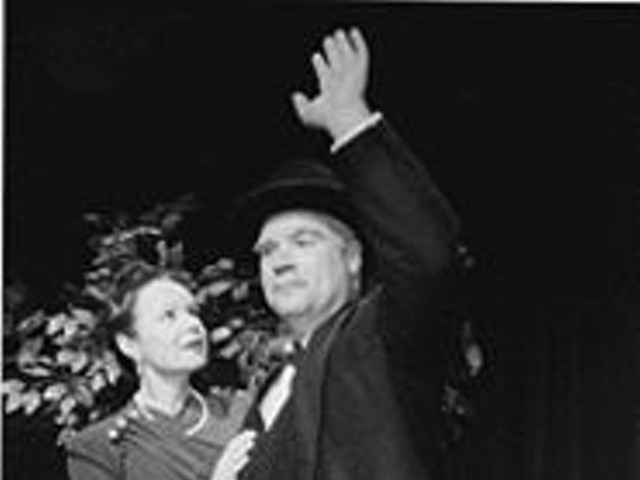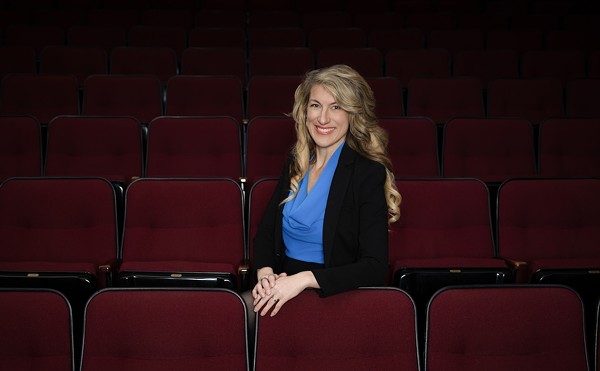Contacted in Cincinnati a week before coming to debut "Naive and Sentimental Music" with the St. Louis Symphony Orchestra, Adams says he's encouraged by the response his most recent symphonic work is receiving. "It's been getting a surprisingly warm response," he says. "Any piece that is that long -- it's 45 minutes long -- and is new and unfamiliar to audiences is a big bite to chew on. I remember when "Harmonielehre' (which the San Francisco Symphony premiered in 1985) came out and it wasn't familiar. People -- well, they weren't unhappy -- but they were a little benumbed by the experience. It's been around long enough now, and fortunately it gets played and it's been recorded twice. Younger people, anyone who's interested in orchestra music tends to know that piece now, at least among the younger generation. So I don't receive the usual tepid, polite response which most contemporary pieces get, unfortunately."
Adams has journeyed into the ranks of respectability, even prominence, since he was a young composer turning from the modernist gods of atonality, following instead the leads of minimalists such as Steve Reich and Philip Glass. "Minimalism was surely one of the most important stylistic revolutions in this century," says Adams. "One of its principle features was a return to a musically simple statement. Of course, there have been composers like Eric Satie and Shostakovich -- who is a very simple composer -- it hasn't been as if they've not existed. The prestige styles of this century have been ones of great musical and rhetorical complexity.
"I think why minimalism was so revolutionary was that it returned to these fundamental building blocks of music: tonality, pulsation and repetition -- all of which had been aggressively destroyed by the avant-garde -- and basically built a whole new language around that."
With such contrarian notions, Adams met both hostility and skepticism when he stood before major orchestras 10-15 years ago, but it's rarely the case now. Adams, especially because of his landmark opera Nixon in China, is known, appreciated, even revered. Beginning work with the SLSO, he finds an admirer in first violinist and concertmaster David Halen. After the daunting first rehearsal of "Naive and Sentimental Music" on Nov. 10, a Wednesday, three days before the piece's St. Louis premiere, Halen takes time in the plushly appointed Whitaker Room of Powell Hall to discuss the work and his appreciation of Adams. Halen, who appears round-faced and boyish onstage, up close is tanned and handsome, distinctly mature and confident. After a few minutes of conversation, he's reclining casually into a corner of the sofa.
"Working with him, for me, is a real revelation," Halen says. "He's the kind of guy I expected from hearing his music. He's very down-to-earth. He's very rhythmically and mathematically gifted. You can tell when somebody's conducting, there's a groove in tempo selection and steadiness. That's one of the reasons his music is written the way it is. He has that natural pulse; it's very well placed and balanced. That's been a major influence on him."
Halen acknowledges that "Naive and Sentimental Music" carries a high degree of difficulty. During the initial rehearsal, individual musicians are seen shaking their heads in exasperation over certain phrases. Although Adams' music can no longer easily be categorized as "minimalist," there remain fundamental idioms of minimalist expression, such as long phrases repeated measure after measure after measure. Orchestral musicians revolted against such demands when minimalist compositions began to make their way into classical-music halls.
"It's very difficult," Halen admits. "It's relentless in its driving rhythms. The note structure is constant. What makes this music so hard is the constant need for focus. If you let your mind relax for a split second, you're off and you can't get back in.
"In my position, if I'm off, then I have 20 people behind me that get lost, and then it's chaos. This is the kind of concert where you have to come in with a really clear head. You have to be overprepared. You have to practice a lot with the metronome -- that's something people think you only do when you're a kid, but you turn that metronome on and you do it until it is drilled and drilled. Then you can relax and let the groove take over, which is what Adams has a natural gift for -- to get to this point where you relax and the music takes its own road and your brain is functioning very smoothly, just like the music sounds, like a very well-oiled machine."
In their first rehearsal, the SLSO hasn't achieved the smooth shiftings of that well-oiled machine. Adams knows where the trouble spots are, though, where musicians need to note transitions or changes in tempo, or to turn contrapuntal rhythms into a lively quarrel among instruments instead of a shapeless brawl.
"Note the gradual accelerando," Adams instructs the orchestra. "You need that to push that big semi up the hill." He asks the violinists for "a more brutal ending" to one phrase. "Listen to the cello -- saving the crescendo and really cutting it off."
After the final movement concludes with a great crescendo of sound -- horns blaring, drums rebounding, keyboards pounding, strings sizzling -- there's a communal sigh of exclamation.
"Just burn rubber," Adams instructs the bass section. "I want to see smoke rising from back there." The bassists look as if this is a directive they heartily appreciate.
Friday morning, Nov. 12, is the fourth and final rehearsal before the first performance that evening. Keeping to the schedule is a nearly incomprehensible feat, considering the scale of the new work the orchestra must master, as well as the rehearsal time needed for the two other works on the program, Rimsky-Korsakov's "Russian Easter" and Rachmaninoff's Piano Concerto No. 2 with soloist Jon Kimura Parker.
"The available work time over the years in American orchestras," Adams observes, "through years of union negotiations and stress on time, has made the actual minutes you spend working with an orchestra so extremely intense that there is little time to do more than just say good morning and say a few pleasant things and go right to work."
"Orchestra rehearsals are amazing in their efficiency," says Halen. "They have to be because you have 100 people out there that are very well paid, and for good reason. They're professionals at the very highest level. So every minute counts; every minute is thousands of dollars, basically. So we don't want to be wasting it."
A lot has changed since Wednesday. "Naive and Sentimental Music" has grown into a more fully realized shape -- fascinating, rather than rigorous, in its complexity. The rhythms and counter-rhythms that reverberate through the orchestra are more defined, and those moments of great, raucous sound are bolder and more expressive. There's no head-shaking today. There is even relaxed -- rather than anxious -- laughter. When Parker arrives to rehearse the piano concerto, after the workout the musicians have gone through on "Naive and Sentimental Music," they relax into the Rachmaninoff as they would into a warm bath.
Saturday night at Powell Hall, the audience is less formal than usual, clad in casual sweaters, open collars, leather sportcoats. A cluster of young girls in evening gowns look a little out of place.
The concert begins with the cool fire of the Rimsky-Korsakov; then Parker plays the Rachmaninoff with great skill, feeling and expression.
After intermission comes the real event of the evening, the debut of "Naive and Sentimental Music." The piece begins slowly, the flutes repeating an insistent phrase with a guitar strumming along. Soon the single phrase dissolves into a pandemonium of rhythms, and the first movement closes with a roaring cacophony of sound.
A few members of the audience hit the exits before the second movement -- a particularly lovely, slow passage that includes the eerie sound of bowed vibraphones.
Still more leave at the end of the second movement, groups briskly making for the exits, looking like people who've been caught at something of which they're ashamed.
When the SLSO concludes "Naive and Sentimental Music," the "tepid, polite response" with which Adams has become too familiar ensues: Most of the audience bustles for the parking lots, looks of annoyance on their faces, as others stand in applause to both praise the orchestra and confront the exodus. A hearty "Bravo" is roared from the rear of the hall.
Pulitzer Prize-winning music critic, and now SLSO artistic advisor, Tim Page has written, "All those listeners who continue to insist they "don't like 20th-century music' have something of a shock in store for them -- it's almost the 21st century, and what will they say then?" The question could be asked of those making their getaways on Saturday night. They flee -- toward what? It's doubtful they find on the dark streets of Grand Center, or on the expressways toward the suburbs, some enclave in which they can safely deny the age, with the clarion of the new still ringing in their ears.





